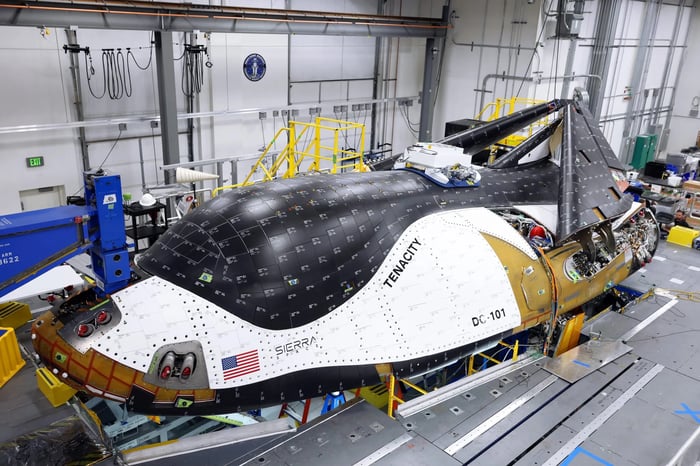Once upon a time, SpaceX was the world's only unicorn space company -- a privately owned space company that would have a valuation well above $1 billion if it could only be convinced to IPO. Not long after, Virgin Orbit (which went bankrupt), Rocket Lab (which didn't), and Firefly Aerospace (which, like SpaceX, hasn't yet IPO'ed) joined this still relatively exclusive club.
Today, investors have yet another space unicorn company to watch, in hopes it will one day IPO: Sierra Space.
Unfortunately, just in time for Christmas...Sierra Space is laying off workers.

Image source: Sierra Space.
Introducing Sierra Space
Sierra Space, for those not aware, is the space company subsidiary of aerospace specialist Sierra Nevada Corporation (not to be confused with Sierra Nevada Brewing Company). Sierra Space laid off "several hundred employees and contractors" last week. And yet, curiously, about 150 Sierra Nevada workers then left the parent company to join Sierra Space to work on "classified contracts."
So maybe things aren't as bad as they seem?
How things seem
It's actually hard to tell.
As the story goes, last week Sierra Space completed more than a decade of work to build its first Dream Chaser spaceplane -- a sort of space shuttle that rides a rocket to orbit to deliver payloads -- to the International Space Station (ISS), for example -- then lands back on Earth on a runway like an airplane. This first Dream Chaser (confusingly bearing another name entirely: Tenacity) was shipped to NASA for pre-launch testing.
Within days of that happy event, Sierra Space began laying off some of the workers it had hired earlier this year to complete the project.
I guess that makes sense. If the construction phase of Dream Chaser is over, those workers aren't needed anymore. And Sierra Space might now want to import other kinds of workers -- nonconstruction types -- from its parent company as it shifts into conducting "operations" with Dream Chaser and doing other "classified national security work," as CNBC describes.
On the other hand, though, cutting construction workers does seem to signal that Sierra is not sufficiently confident in the final product, or in how NASA will react to it, that it's willing to keep those employees on staff to build additional units.
That doesn't sound like such great news to me. Read in the context of Sierra Space also losing two key executives earlier this month, Chief Operating Officer Jeff Babione and Senior Vice President of Space Destinations Neeraj Gupta, the news is a bit worrisome. Sierra itself says the departures and the layoffs aren't related.
But I wonder.
Is Sierra Space being penny-wise and pound-foolish?
And I must say, the news of layoffs and executive departures doesn't quite jibe with the more positive reports on Sierra Space we've seen recently. Just back in September, for example, Sierra Space became one of the world's most valuable unicorn companies when it raised $290 million in new cash -- hiking its private market valuation past $5 billion.
Granted, much of this money was probably used to finish up work on Dream Chaser. But you'd think there'd be some money remaining to retain the workers who had built the spaceplane -- you know, just in case Sierra Space might want to build another one?
Because space is hard, as the saying goes. And sometimes things go wrong. Sometimes...rockets blow up, taking their payloads with them.
The risk Sierra Space is running
Sierra Space has finished one Dream Chaser, and this spaceplane is due to launch on a United Launch Alliance Vulcan Centaur rocket sometime next year. Still, there's no guarantee the mission will succeed. (Vulcan itself, after all, has never flown before). Given the risks inherent in test-flying spacecraft -- this will be Dream Chaser's first flight and only Vulcan's second flight when it happens -- you might think Sierra Space would want to have a spare in stock, just in case the first attempt goes awry.
More optimistically (and more in line with its $5.3 billion private market valuation), you might also think Sierra Space would want to spend some of its $290 million in new money to expand production and build more Dream Chasers -- just in case the spaceplane's first flight goes fabulously right. After all, alongside rivals SpaceX and Northop Grumman, Sierra Space is now one of just three companies holding NASA contracts to run supplies to the ISS. Furthermore, Sierra supposedly has plans in place to use Dream Chaser to transport astronauts to the ISS, which would permit it to compete with SpaceX and Boeing for that contract as well.
Factor in the potential to use Dream Chaser for space tourism and for transport missions to the moon or to one of the several private space stations companies are talking about building, and it seems to me Sierra Space has multiple potential markets for Dream Chaser -- and more than a fair shot of growing big enough to justify an IPO of the company.
Hanging all these hopes on just one single spaceplane, however, seems risky to me. Sierra Space shouldn't be laying off workers. It should be adding more.




